|
|
 |
Bike Virginia was a grand adventure, and a challenging workout for us. We traveled 222 miles over the five days
of the ride, explored many scenic byways and historic sites, and enjoyed sharing the experience with new friends from our
Savannah Biking Club and old friends from Cincinnati.
We also shared the experience with 2,000 other bikers from all over North America. It was exciting to be part of
such a big colorful group of riders, especially when we converged at rest stops and meals and scheduled events. Our
colorful jerseys created a festive atmosphere wherever we went (and served as great conversation starters, since many bore
the names of people's clubs or past rides).
We got to recognize a few distinctive riders along the way. There was a family with a custom made four person
bicycle, pedaled by the father in the front seat, with two children about ages four and six pedaling in two seats,
and a non-pedaling baby strapped into a safety seat. Mom rode behind on a bicycle with a baby trailer that
provided an alternative spot to carry the youngest. One day we watched the four person bike go by with one of the little
girls asleep with her head resting on the handlebars, and her feet strapped to the turning pedals. On the hottest
day, we saw they had a custom canopy rigged to cover the whole bicycle and shade all the riders. That dad was one strong
biker to power that rig!
Another interesting couple had a tandem bicycle. The woman rode in the front position, taking care of all the steering
and gearing, and her husband rode in the back strumming a baby blue ukelele and singing to her.
The scenery and the people-watching were great, the places we rode were abundant with natural beauty and historic
import, and we had a grand adventure.
Here are the highlights:
|
 |
|
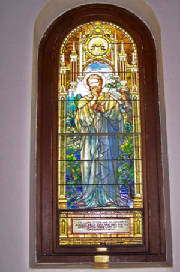
|
| Georgia window in Blandford Church |
Saturday, June 23 Petersburg Loop
44 miles
We met up with Cincinnati friends Susan Small and Bill Luerssen to share the day's ride on winding roads through the
fields and woods of Petersburg National Battlefield, into Old Towne Petersburg, to lunch on the lovely campus of Richard Bland
College (a two year college division of the College of William and Mary), and then back to Hopewell along mostly rural roadways.
The Petersburg Battle in 1864 was ten months long, the longest seige of any American city. The battlefield is famous
for a crater formed when Pennsylvania coal miners dug under Southern lines to detonate explosives to break their line of defense.
The strategy backfired sopmewhat when Union troops fell in the gaping hole trying to charge the Confederates after the
blast. We parked our bikes and walked to the crater, which was a bit of a disappointment -- it had filled in over time.
Other cyclists suggested we walk down a long path from the crater to the mouth of the tunnel the miners dug. From that
perspective, their construction feat was far more impressive.
On our ride through the city of Petersburg, we stopped at Blandford Church, built on the highest point in the Petersburg
in 1735. The church was used as a Confederate field hospital during the Seige of Petersburg, and in 1901, the Ladies
Memorial Association of Petersburg began a project to restore the church as a Confederate Memorial Chapel to honor the 30,000
Confederate soldiers buried in the cemetery covering the hills around the church. Each of the former Confederate states
honored their soldiers by funding a memorial stained glass church window designed and executed by the Louis Comfort Tiffany
Studio in New York.
To honor our new Confederate state home, we photographed the Georgia window. The dedication text at the bottom
of the window reads: "To the glory of God-In memory of Georgia's brave sons who died for the right-Giving their lives to the
Confederate Cause."
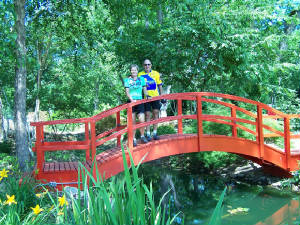
|
| Richard Bland College Water Garden |
The highlight of our lunch stop at the Richard Bland College (besides the food -- we had worked up an appetite riding)
was their tranquil Japanese Water Garden. The pond edges were lined with stunning pale pink lotuses rising on slender
stems several feet above the water, and they glowed as the sun lit their translucent petals. We took many photographs
to try to capture the beauty of the spot.
We ended the day with dinner in a big tent in downtown Hopewell, which was holding a "Taste of Hopewell" event near our
tent, providing us with a little musical entertainment before we headed back to our hotel for an early turn in, anticipating
a long ride tomorrow.
Sunday, June 24 Hopewell to Williamsburg
61 miles
We had so much fun riding with Bill and Susan yesterday, we rode with them again today. Our ride to Williamsburg
took us along the mainly rural roads of Surry County lined with woods, a few small towns, and lots of corn and grain fields,
a couple small cotton fields, and what we thought might be soy fields, but no tobacco fields that we could recognize. Tobacco
was the crop that launched the prosperity of this region long ago, but it doesn't appear to be the crop of choice any
longer.

|
| Riding the bikers only ferry |
The highlight of the day was a ferry ride across the James River from Surry County to James City County. We waited
in a line of hundreds of riders that snaked through a big dirt parking lot, and were released in groups to board the ferries,
which ran every half hour. The bike tour organizers ordered an extra ferry for us, and we were lucky enough to be on
the bikes only ferry, providing for a convivial ride across.
As we neared the shore, we got a preview of coming attractions as we saw the fort and three ships of the "recreated"
Jamestown Settlement, and the monument and palisades built on the site of the real Jamestown right next door. Jamestown
was our Tuesday, June 26 destination.
We dined with at least a thousand other meal plan riders beneath a tent in the New Town area of Williamsburg. New
Town is like many generic developments we have seen popping up throughout the coastal South -- a big chunk of cleared land
with streets lined with buildings designed to look historic, but without the sags and dings and layers of paint that give
historic buildings their character. The main streets have chain shops and restaurants on the street level and condos
above, and the side streets are lined with row houses and condos. The outskirts will probably be "estate homes," if
New Town follows the usual pattern, but right now it is acres of dusty red cleared soil dotted with grading equipment and
survey stakes.
After dinner, we couldn't resist a trip to Barnes and Noble, even though our boat is bursting with books already.
We have decided that if we ever needed ballast, we wouldn't use bricks and rocks like those mariners of old, we would use
books, and plenty of them.
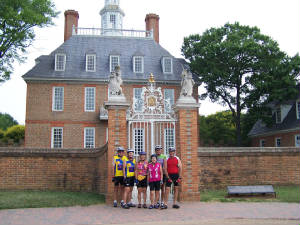
|
| Savannah bikers in front of the Colonial Williamsburg Governor's Palace |
Monday, June 25 Yorktown Loop
45.5 miles
We rode with our Coastal Bicycle Touring Club from Savannah today. We began our tour with a ride through Colonial
Williamsburg as all the staff were walking to work.
Then we rode the National Park Service Colonial Parkway from Williamsburg to Yorktown. The parkway is made of slabs
of cement embedded with big stones, laid with seams about an inch wide between them. This made for a very vibratory
ride, and a dangerous one, as unwary cyclists trying to pass got their wheels grabbed by the centerline road groove and
went flying off their bikes. We saw four ambulances carrying away injured riders, and saw other riders nursing lesser
wounds roadside. We emerged unscathed.
Besides being perilous for cyclists, the parkway is very scenic, passing through woods, verdant green swamplands, and
along the shore of the York River, then circling through the now tranquil Revolutionary War battlefield area. We stopped
at every roadside sign along the way to read about the historic import of the places we passed.
The 1781 Battle of Yorktown was the last major battle of the American Revolution. We stopped to view Surrender
Field, the battlefield where Cornwallis surrendered his army; and the Augustine Moore House, where officers from both
sides negotiated the surrender terms.
We lunched in a Yorktown park picnic area beside the York River, then stopped in the Waterman's Museum in town, where
we learned a little more about the men who make their living plying the waters of the Chesapeake and its tributary rivers.
One of our fascinations as we cruise is watching men working the waters from their boats -- tending their
crab traps, dragging shrimp or fish nets, tonging for clams or oysters. One of the many things we learned at the museum
is that Virginia has an official state boat -- the deadrise -- a tribute to the men who harvest the bounty of Virginia's
tidal waters.
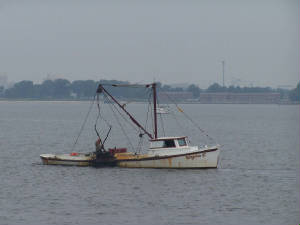
|
| Tonging on a deadrise |
We ended our day with our best dinner of the trip, in the cafeteria of The College of William and Mary -- the seconld
oldest college in the country, established in 1693. After dinner, we strolled the beautiful grounds of the college,
and attended an extraordinary musical and educational performance by Timothy Seaman. His primary instrument is
hammered dulcimer, but he also played piano, bamboo and silver flutes, several whistles, a mountain dulcimer, and other
instruments during the two sets we heard.
He specializes in music inspired by Virginia places and natural resources, and he talks about his instruments and inspirations
between the pieces he plays. One of my favorites was a composition entitled "Who's Awake? Me Too!" based on the calls
of the Great Horned Owl and the Northern Bobwhite, whose scientific names both honor Virginia (Bubo virginianus and
Colinus virginianus, repectively.)
We were so entranced by his playing that we bought two of his CDs. Virginia Wildlife has tunes
inspired by the Virginia state insect (the Eastern Tiger Swallowtail), fish and shellfish, bears, raccoons, and lots
of birds, including Bald Eagles, Cuckoos, Redwing Blackbirds, Mockingbirds, and, of course, my "Whose Awake? Me Too!" birds.
Jamestown: On the Edge of a Vast Continent celebrates the 400th Anniversary of Jamestown with traditional melodies
and original compositions honoring aspects of the settlement's history. We listened to both CDs on our flybridge as
we made our way downriver after the ride was over, and they are splendid reminders not just of the concert, but of our entire
tour of Virginia, savoring the historic sites and the natural beauty of the Colonial Coast.
Tuesday, June 26 Jamestown Loop
23 miles
We were back on the bumpy Colonial Parkway again today ("offering a free massage with every ride" as many riders
joked). Our group apparently learned their lessons about cautious riding from yesterday's injuries, and we failed to
see an ambulance carrying anyone away from the Jamestown ride.
There were multiple mileage route options for today's ride, ranging from 28 miles to 100 miles. As you can see
from our mileage above, we managed to undercut the lowest mileage option by five miles. We simply rode to Jamestown,
enjoyed thoroughly all the historic attractions there, and took the return route back to Williamsburg, skipping a scenic loop
through an area of Jamestown Island labeled "Pitch and Tar Swamp." We figured we had seen plenty of swamps and didn't
need to see any more today. We are saving our energy for tomorrow's ride, when temperatures are predicted to be over
ninety degrees (as they are today), and we have to ride nearly fifty miles to get to Hopewell.
I should add that by not choosing to ride the 44, 62 or 100 mile routes, we missed out on attending the wedding
of two longtime Bike Virginia participants and volunteers. They married at a park which was the lunch stop for the longer
rides, and invited anyone riding to come to the wedding. This was at least the second wedding that has taken place
during a Bike Virginia tour, and multiple marriage proposals have also been made during Bike Virginia.
We shared a table at dinner with a couple who were just engaged a few days before this year's Bike Virginia -- the man
had intended to propose here, but just couldn't wait. They met at a bike club ride, after the man had an injury that
caused him to ride in the middle of the pack of riders, instead of riding in his usual spot with the racing men up front.
He said his friends were always complaining they didn't meet any women on club rides, and he told them they just needed to
slow down.
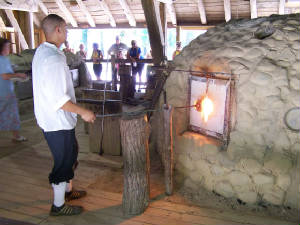
|
| Jamestown Glassblower |
But, back to Jamestown, which is celebrating the 400th anniversary of its founding this year -- we covered
it thoroughly and savored all we saw. We watched the orientation movie in the Information Center, we pretended to be
new arrivals to the Island as a first person interpreter in period costume walked us around and oriented us to the discomforts
and dangers of the place (he was a splendid actor), and we took a walking tour guided by a perky National Park Service Ranger.
We visited the archaeological dig of the original fort, where we felt very sorry for the student interns digging there with
no tent or tarp sheltering them from the sun, while we tourists stood beneath an awning to watch them and learn about
the discoveries at the site. To see some of their finds, we then headed for the Archaerium, a new history museum with
a focus on archaeology built on the site of the historic town.
Our final stop was at the Glasshouse, where we saw the person who has the worst job in all of Jamestown today (even worse
than the students digging in the sun). He is a glass blower, dressed in period attire, who blows glass bottles all day
long -- constantly pulling molten glass out of one furnace and putting it into another with brief intervals of blowing and
shaping the glass inbetween. We were plenty hot and sticky standing outside the safety railings wearing lightweight
sport clothing designed to wick sweat away. We couldn't imagine how that glass blower was managing to do his job with
such seemingly effortless aplomb.
By the time we rode back to Williamsburg, it was afternoon, the temperature had climbed into the nineties, and the
humidity was so high it seemed the air couldn't summon the energy to evaporate our sweat. We congratulated ourselves
on having the wisdom to cut five miles off the route today, and we wondered if we would have the endurance to make it through
fifty miles of riding in even worse heat tomorrow, when cutting miles off the route is not an option.

Wednesday, June 27 Williamsburg to Hopewell
48 miles
222 total tour miles
We can't leave Williamsburg without sharing our stocks photo. Does anyone leave Williamsburg without having someone
snap a photo of them in the stocks? Our family has a photo of my mother in the stocks (before I was born, I think), and
of my sister and me at about ages six and eight, and now Dick and I can add this photo to the collection. Try as I might,
I can't explain the seemingly universal fascination with this pose, but I can tell you we wanted this photo op so badly that
we actually stood in line and waited for the privelege of putting our heads through the holes of shame.
We didn't take this picture on Wednesday, though. Riding with friends Bill and Susan again today, we had no time
for dilly-dallying about. We were on our way out of town by 7:30, hoping to beat the heat by front-loading our miles
into the cooler morning hours. Through the first half of the ride, our stategy worked -- we rode along narrow pretty
flat country roads shaded by a canopy of trees, and the miles flew by pleasantly.
We had to cross a couple large bridges, and the police held us up until we had a big group, then stopped traffic to escort
us with police cars in front of and behind us, as we took over the bridge with a mass of bicycles. Thus, the bridge
crossings took on a festive air of celebration.
When we got to the final rest stop, we had a decision to make. We could either take a shuttle bus to historic Berkeley
Plantation for a tour before we rode on, or we could skip the Plantation and continue our ride to Hopewell. Since the
temperature was already in the high 80s and increasing by the minute, the vast majority of riders chose to ride on.
We decided to take the road less traveled, knowing we would pay in sweat equity later in the day.
We enjoyed our tour of the plantation house, built in 1726 by Benjamin Harrison IV and his wife Anne. They sealed
their love, and the house's provenance, with a stone carved with their initials, a heart and the date, set high in the
wall of the house beneath its eaves. Thanks to that stone, their handsome Georgian manor is the oldest three story brick
house in Virginia that can prove its age.
Benjamin's son and grandson, both born in the house, went on to distinguished political careers. Benjamin Harrison
V served in political office for 42 years, including three terms as governor of Virginia, and he was one of the signers of
the Declaration of Independence. His son, William Henry Harrison, was our ninth President.
Before the house was even built, though, the site of the plantation accumulated other claims to fame. In 1619, English
settlers came ashore at a spot reputed to be on Berkeley's grounds, and, by order of the King, got on their knees and thanked
God. This act qualified Berkeley as the site of the first official Thanksgiving in America, at least according to the
folks who run Berkeley. We are thinking that certainly the folks at Jamestown gave thanks when they arrived a dozen
years before the settlers at Berkeley, and all the Spanish priests who arrived even before that down in Florida surely
gave thanks (but, maybe since they did it in Spanish, it wasn't "official"). So, we find the first Thanksgiving claim a
little shakey.
Regardless of whether they can claim the first Thanksgiving, we know that the settlers there were thankful when
they were able to use the bounty of Berkeley to distill the first Bourbon Whiskey made in America in 1621. On a more
sober note, "Taps" was composed at Berkeley while Union Forces were encamped on the plantation during the Civil War.
When we were done touring the house, a museum in its basement, the grounds and the gift shop, we caught a shuttle
back to the rest stop and were a little surprised to find that scarcely a biker was left there.
We hopped back on our bikes, and set out on the last leg of our tour. The sun was high in a cloudless sky, the
roads we traveled were no longer shaded, and the temperatures and humidity were still rising. The final miles
were the most miserable of the tour, and of our riding experience together ever. Before we finished, we saw the
thermometer on my bicycle hit 104, a new record.
But, it's over now, and our misery is fading in our memory. We have official Bike Virginia patches, tee shirts,
bike jerseys and passports stamped with stops we made along the way to remind us of our accomplishment.
We didn't waste any time resting on our laurels. After eating our post-ride lunch and celebratory cake, and bidding
a fond farewell to Bill and Susan, we called a station wagon cab, threw our bikes in the back, headed to a grocery store
to reprovision and then back to the boat.
There we popped open a bottle of champagne to celebrate accomplishing 222 miles of grand adventure on our bikes.
After showers, we settled in to planning our next adventure afloat -- exploring the Chesapeake.
|
 |
|
|
 |
|
|
 |
|
|
|
|
|
|
 |

